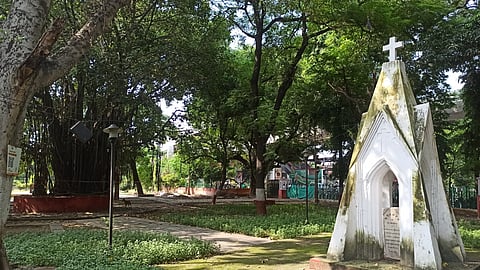The Awadh region, constituting the present-day Lucknow and nearby areas, played a crucial role in many events during the British Era. The Capital city was once the epicentre of British military actions, and has witnessed various uprisings and freedom movements. As a result, traces of history from the era can be found all over the town. And here's a lesser-known one-
Memorial that dates back to 1857
Among these imprints of colonialism within Lucknow, the 'Victims of 1857' memorial stands as a lesser-known piece of history. This memorial dating back to the 18th century, was erected by the Britishers during the aftermath of India's Fist Rebellion and is located inside the Raja Jay Lal Singh Park in Hazratganj near K.D. Singh Babu Stadium.
A remnant of India's First Rebellion
This memorial is located inside a verdant park, right beneath K.D. Singh Babu Stadium Metro Station, opposite Tulsi Cinema. Although located in a very busy area, flocked by crowds daily, very few of the city dwellers know that the spot has great historical significance and features a statue of 'Amar Shaheed Raja Jay Lal Singh' along with the Memorial of European Captives.
The tale behind the establishment of the memorial
The memorial has its roots in the historical events of 1857-58, during which incidents occurred involving European captives and some deserters from the Bailie Guard. These events took place during the rebellion led by Raja Jay Lal Singh, a local ruler.
The memorial serves as a commemoration, remembering those who lost their lives during this period. The inscription on the Victims of 1857 memorial reads as follows: "Sacred to Memory of I.G.P. Carew Esquire, Mrs. Greene, Miss Jackson and others. Europeans and Natives, Faithful Servants of Government, Victims of 1857."
The other slate on the memorial reads the names of several other victims – Sir Mountstuart Jackson, Captain Patrick Orr, Lieutenant Burns and Sergeant Morton.
The park also accommodates a majestic, decades-old Banyan tree
The location coincides with the same place where the European victims tragically met their fate, and it was also where Raja Jay Lal Singh faced execution by the British in 1859. This park, adorned with lush greenery, prominently featuring a majestic, decades-old Banyan tree, provides a peaceful space for both passersby and local workers to relax.
Knock Knock
Today, the memorial of the victims and the statue of their erstwhile adversary, Raja Jay Lal Singh coexist harmoniously in the very same place.
Furthermore, for those with a penchant for delving into history's depths, the comprehensive account of this incident can be discovered etched onto slates placed inside the park.
To get all the latest content, download our mobile application. Available for both iOS & Android devices.

